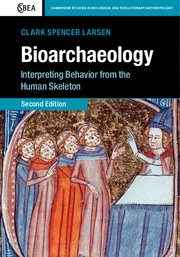Book contents
- Frontmatter
- Dedication
- Contents
- Preface to the Second Edition
- Preface to the First Edition
- 1 Introduction
- 2 Stress and deprivation during growth and development and adulthood
- 3 Exposure to infectious pathogens
- 4 Injury and violence
- 5 Activity patterns: 1. Articular degenerative conditions and musculoskeletal modifications
- 6 Activity patterns: 2. Structural adaptation
- 7 Masticatory and nonmasticatory functions: craniofacial adaptation to mechanical loading
- 8 Isotopic and elemental signatures of diet, nutrition, and life history
- 9 Biological distance and historical dimensions of skeletal variation
- 10 Bioarchaeological paleodemography: interpreting age-at-death structures
- 11 Bioarchaeology: skeletons in context
- References
- Index
- Plate section
8 - Isotopic and elemental signatures of diet, nutrition, and life history
Published online by Cambridge University Press: 05 April 2015
- Frontmatter
- Dedication
- Contents
- Preface to the Second Edition
- Preface to the First Edition
- 1 Introduction
- 2 Stress and deprivation during growth and development and adulthood
- 3 Exposure to infectious pathogens
- 4 Injury and violence
- 5 Activity patterns: 1. Articular degenerative conditions and musculoskeletal modifications
- 6 Activity patterns: 2. Structural adaptation
- 7 Masticatory and nonmasticatory functions: craniofacial adaptation to mechanical loading
- 8 Isotopic and elemental signatures of diet, nutrition, and life history
- 9 Biological distance and historical dimensions of skeletal variation
- 10 Bioarchaeological paleodemography: interpreting age-at-death structures
- 11 Bioarchaeology: skeletons in context
- References
- Index
- Plate section
Summary
Introduction
Documentation of past foodways is not only intrinsically valuable, but it also provides the requisite resource context for evaluating effects of nutrition on growth and development, assessing stress and disease from paleopathological indicators, and interpreting skeletal adaptation, among other topics discussed in the foregoing chapters. There is a range of conventional approaches for characterizing past diets and inferring nutritional outcomes, including analysis of plant and animal remains, coprolites, pottery residues, and tools used for food production and consumption. These approaches provide a record of what foods were consumed, but do not give a representation of the proportions of foods or food classes consumed by past populations. The poor preservation of plants in many archaeological contexts, for example, inhibits documentation of their role in diets in many settings. Food refuse is often subject to preservation-related biases that prevent accurate or otherwise meaningful nutritional interpretation. Moreover, food refuse deriving from ritual uses may or may not have been eaten.
Beginning in the late 1970s, a collaboration between an archaeologist and a geochemist on the analysis of stable isotope composition of carbon in archaeological human remains (van der Merwe & Vogel, 1978; Vogel & van der Merwe, 1977) started a revolution in dietary reconstruction having implications for issues of interest in the study of past populations, all linked either directly or indirectly to diet. Following this pioneering research, stable isotopes have become a standard data set for addressing fundamental questions about diet and dietary adaptation in past populations, enhancing our ability to characterize past human diets and their variation in general (Burton, 2008; Katzenberg, 2008; Lee-Thorp, 2008; Schoeninger, 2010). Simply, the documentation of isotope signatures passed from the foods being eaten to the consumer allows the identification of diet with considerably greater precision than with conventional archaeological data involving recovery of plant and animal remains alone. These biochemical signatures do not represent a “reconstruction” of diet; rather, they facilitate the identification of consumption profiles of different foods eaten by past populations. If consumption profiles are identified accurately, then it becomes possible to get at the real “meat” of the matter, namely, nutritional inferences and broader implications for understanding past human adaptation in a broad biocultural context.
- Type
- Chapter
- Information
- BioarchaeologyInterpreting Behavior from the Human Skeleton, pp. 301 - 356Publisher: Cambridge University PressPrint publication year: 2015
- 2
- Cited by

